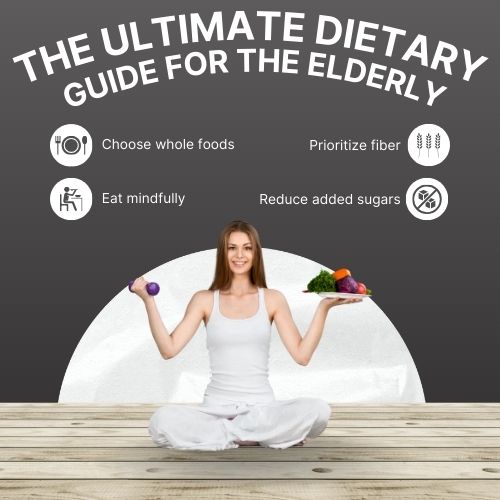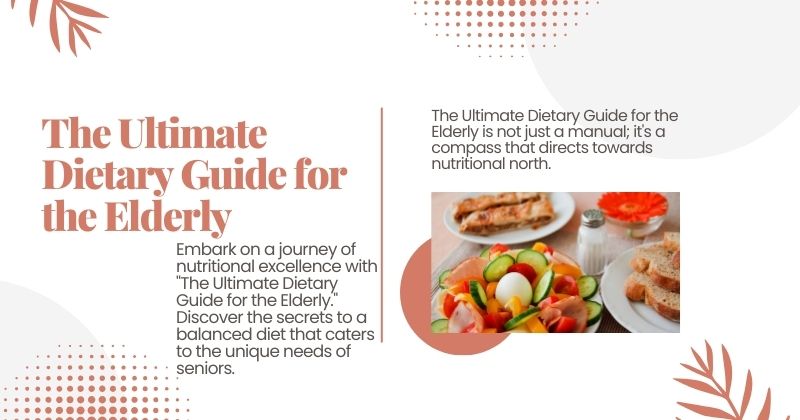The Ultimate Dietary Guide for the Elderly
As we gracefully step into our golden years, our bodies begin to tell tales of the times, whispering the need for change, especially in our diet. The Ultimate Dietary Guide for the Elderly is not just a manual; it’s a compass that directs towards nutritional north. It’s a narrative woven from the threads of well-being, tailored to fit the fabric of senior living. Let’s embark on this journey together, shall we?
Embark on a journey of nutritional excellence with “The Ultimate Dietary Guide for the Elderly.” Discover the secrets to a balanced diet that caters to the unique needs of seniors. Learn how to nourish the body and soul with this comprehensive and engaging guide.
Imagine your body as a vintage car. It’s classic, valuable, and with the right maintenance, it can run smoothly for many years. As time passes, this car requires more specific care – a tweak here, a replacement there – all to ensure it keeps purring along. Similarly, as we age, our bodies need tailored nutrition. This is where “The Ultimate Dietary Guide for the Elderly” comes into play, serving as your personal mechanic in the world of senior nutrition.

Understanding the Nutritional Needs of Seniors
The Metabolic Shift
As we age, our metabolism downshifts. It’s like going from a sprint to a leisurely stroll. This means we need fewer calories but more of certain nutrients – a paradox that requires a delicate balancing act.
The Nutrient Density Focus
Imagine your plate is a treasure map. The X marks foods rich in vitamins, minerals, and fiber, yet low in calories. These are the gems we’re after – the leafy greens, the colorful fruits, the lean proteins, and the hearty whole grains.
Crafting the Perfect Senior Diet
The Macronutrient Trio
- Proteins: The building blocks. Think of them as the repair crew, fixing and maintaining your body’s tissues. Aim for lean sources like fish, poultry, and legumes.
- Carbohydrates: The energy providers. They’re the fuel that keeps the engine running. Opt for complex carbs like whole grains and vegetables over simple sugars.
- Fats: The supporters. Healthy fats are like the oil that keeps everything running smoothly without friction. Sources like avocados, nuts, and olive oil are your go-tos.
The Vital Vitamins and Minerals
- Calcium and Vitamin D: The bone fortifiers. They work in tandem, like a superhero duo, to keep your bones sturdy and your smile bright.
- B Vitamins: The energy releasers. They’re like the spark plugs of your body, igniting the energy from the food you eat.
- Antioxidants: The protectors. These are your bodyguards against cellular rust, keeping you looking and feeling vibrant.
The Hydration Equation
Water is the elixir of life. It’s the river upon which nutrients sail to reach their destinations within your body. Aim for fluids like water, herbal teas, and other non-caffeinated, sugar-free beverages to stay well-hydrated.
Special Dietary Considerations for the Elderly
Digestive Dynamics
As we age, our digestive system can become more of a slow-moving river than a rushing stream. Fiber becomes a critical player, helping to maintain that flow. Think of fiber as the boats that keep everything moving along the digestive canal.
The Sodium Snare
Salt is like a siren’s call – enticing but dangerous in excess. High blood pressure and heart issues are not uncommon in our later years, making it essential to steer clear of the sodium trap.
Meal Planning and Preparation: A Palette of Nutrients
The Art of Meal Prepping
In the studio of my kitchen, I see each meal as a potential masterpiece waiting to emerge. Meal prepping is not just about saving time; it’s an act of self-care, ensuring that every dish I create is infused with the right balance of nutrients. It’s about painting with proteins, sketching with fibers, and shading with vitamins. By preparing meals ahead of time, I set the stage for a week of nutritious eating, much like an artist prepares their canvas and materials before the brush even touches the paint.
Here’s a table that outlines a week of meal prepping, designed to provide a balanced diet that’s as colorful and varied as an artist’s palette:
| Day | Breakfast | Lunch | Dinner | Snacks |
| Monday | Greek yogurt with mixed berries | Quinoa salad with mixed vegetables | Grilled chicken with steamed broccoli | Almonds and a small apple |
| Tuesday | Oatmeal with sliced banana | Turkey and avocado wrap | Baked salmon with roasted asparagus | Carrot sticks with hummus |
| Wednesday | Scrambled eggs with spinach | Lentil soup | Beef stir-fry with brown rice | Greek yogurt with honey |
| Thursday | Whole grain toast with almond butter | Chicken Caesar salad | Shrimp and vegetable kebabs | Sliced cucumber with cottage cheese |
| Friday | Smoothie with spinach and berries | Tuna salad on whole grain bread | Turkey meatballs with zucchini noodles | Mixed nuts |
| Saturday | Egg muffins with veggies | Veggie and hummus pita pocket | Grilled pork chop with apple sauce | Fresh fruit salad |
| Sunday | Pancakes with fresh strawberries | Leftover turkey meatballs | Baked cod with sweet potato fries | Dark chocolate and raspberries |
The Simplicity of Cooking
When it comes to cooking, I embrace the simplicity that nature provides. There’s a profound beauty in the basics – the earthy scent of rosemary, the sharp tang of lemon, the bold punch of garlic. These are the flavors that bring my dishes to life without the need for excessive salt or fat. It’s about creating a symphony of flavors that dance on the taste buds, making each meal a celebration of the senses.
Here’s a guide to using herbs and spices to create that symphony:
| Herb/Spice | Pairs Well With… | Tips for Use |
| Basil | Tomatoes, garlic, lemon | Fresh basil leaves add a burst of flavor to salads and are perfect in pesto. |
| Rosemary | Chicken, potatoes, bread | Use sprigs of rosemary to infuse oils or to season meats. |
| Cumin | Beans, lentils, rice | Ground cumin adds depth to spice blends and is essential in many curries. |
| Turmeric | Cauliflower, rice, soups | A pinch of turmeric brings warmth and color, as well as anti-inflammatory benefits. |
| Cinnamon | Apples, oats, sweet potatoes | Cinnamon can sweeten dishes without sugar and adds warmth. |
| Paprika | Eggs, meats, stews | Smoked paprika adds a subtle heat and is great for rubs and marinades. |
| Ginger | Carrots, soups, stir-fries | Fresh ginger brings a zesty kick to dishes and aids digestion. |
By prepping meals ahead of time and embracing the simplicity of cooking with natural herbs and spices, I ensure that my diet is as rich in flavor as it is in nutrients. This approach to meal planning and preparation is not just about feeding the body; it’s about nourishing the soul with every bite.
The Role of Supplements
Think of supplements as the understudies in a play. They’re not the stars, but they’re ready to step in when a nutrient might be running low in your diet. Always consult with your healthcare provider before adding any new supplement to your routine.
Staying Active: The Companion to Diet
Physical activity is the dance partner to diet. Together, they waltz in harmony, keeping your body in rhythm. Even gentle activities like walking or tai chi can make a significant difference.
FAQs
How often should seniors eat?
Think of your meals as a series of small, regular performances rather than one grand show. Eating smaller, balanced meals with snacks in between can keep your energy levels steady throughout the day.
What if I have dietary restrictions?
Consider dietary restrictions as a personalization of your nutritional journey. Work with a dietitian to tailor your map to ensure you’re not missing out on essential nutrients.
How can I make my meals more appealing?
Engage all your senses. Make your plate a canvas of colors, textures, and aromas. Remember, we eat with our eyes first!
Conclusion
Navigating the nutritional needs of our later years can be as thrilling as charting a course for a grand voyage. With “The Ultimate Dietary Guide for the Elderly,” you’re equipped with the knowledge to make informed choices, ensuring that your journey is not just about adding years to your life, but life to your years. So, let’s raise our glasses (of water, of course) to health, to vitality, and to the delicious adventure that awaits on our plates. Bon appétit!
Recommended Post for You
- Uncover the Best Diets for Seniors: Secrets to Aging Gracefully
- Real Diet Advice: Transformative Tips Beyond the Hype
- Real Diet Advice: The Health Secret They Don’t Want You to Know!
- The Future of Health: Real Diet Advice
- Real Diet Advice: Your Best Friend in Weight Loss
- Unveiling The Magic of Real Diet Advice: A Comprehensive Guide
- Debate Settled: Real Diet Advice is Key to Health Success!
- Quick and Easy: 5 Real Diet Advice Tips for Busy People
- How Real Diet Advice Transformed My Life – A Personal Story
- Why Real Diet Advice is The Next Big Thing in Health
Reference Link for Further Study
- National Institute on Aging – Nutrition and Aging:
- https://www.nia.nih.gov/health/topics/nutrition This resource from the National Institute on Aging provides comprehensive information on healthy eating as you get older, offering tips on how to adapt your diet to your nutritional needs during the aging process.
- Academy of Nutrition and Dietetics – Nutrition for Older Adults:
- https://www.eatright.org/health/wellness/healthy-aging/nutrition-for-older-adults The Academy of Nutrition and Dietetics offers guidance tailored for older adults, covering the importance of nutrients, managing chronic diseases with diet, and understanding the unique challenges the elderly face when it comes to nutrition.
- Harvard Health Publishing – Nutrition for Seniors:
- https://www.health.harvard.edu/topics/nutrition-for-seniors Harvard Health Publishing provides articles and resources that delve into the nutritional needs of seniors, discussing how to maintain a balanced diet and addressing common health concerns that can be managed through nutrition.
- Mayo Clinic – Senior Health: How to Prevent and Detect Malnutrition:
- https://www.mayoclinic.org/healthy-lifestyle/caregivers/in-depth/senior-health/art-20044699 This resource from the Mayo Clinic discusses the prevention and detection of malnutrition in the elderly, a critical aspect of senior health that can impact overall well-being and quality of life.
Each of these references offers a wealth of knowledge, from practical dietary advice to scientific research on aging and nutrition. They are invaluable for anyone looking to deepen their understanding of how to nourish the body and soul during the later stages of life. Whether you’re a senior yourself, a caregiver, or simply interested in the subject, these resources will guide you towards making informed and healthful dietary choices.
